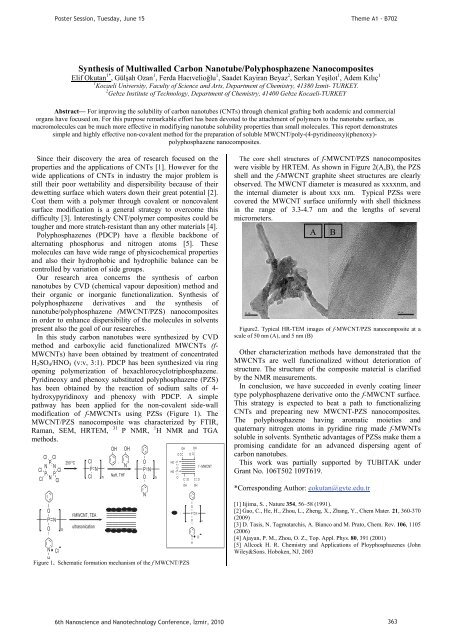Photonic crystals in biology
Photonic crystals in biology
Photonic crystals in biology
Create successful ePaper yourself
Turn your PDF publications into a flip-book with our unique Google optimized e-Paper software.
C<br />
C<br />
Poster Session, Tuesday, June 15<br />
Theme A1 - B702<br />
Synthesis of Multiwalled Carbon Nanotube/Polyphosphazene Nanocomposites<br />
Elif Okutan 1* , Gülah Ozan 1 , Ferda Hacveliolu 1 , Saadet Kayiran Beyaz 2 , Serkan Yeilot 1 , Adem Klç 1<br />
1 Kocaeli University, Faculty of Science and Arts, Department of Chemistry, 41380 Izmit- TURKEY.<br />
2 Gebze Institute of Technology, Department of Chemistry, 41400 Gebze Kocaeli-TURKEY<br />
Abstract— For improv<strong>in</strong>g the solubility of carbon nanotubes (CNTs) through chemical graft<strong>in</strong>g both academic and commercial<br />
organs have focused on. For this purpose remarkable effort has been devoted to the attachment of polymers to the nanotube surface, as<br />
macromolecules can be much more effective <strong>in</strong> modifiy<strong>in</strong>g nanotube solubility properties than small molecules. This report demonstrates<br />
simple and highly effective non-covalent method for the preparation of soluble MWCNT/poly-(4-pyrid<strong>in</strong>eoxy)(phenoxy)-<br />
polyphosphazene nanocomposites.<br />
S<strong>in</strong>ce their discovery the area of research focused on the<br />
properties and the applications of CNTs [1]. However for the<br />
wide applications of CNTs <strong>in</strong> <strong>in</strong>dustry the major problem is<br />
still their poor wettability and dispersibility because of their<br />
dewett<strong>in</strong>g surface which waters down their great potential [2].<br />
Coat them with a polymer through covalent or noncovalent<br />
surface modification is a general strategy to overcome this<br />
difficulty [3]. Interest<strong>in</strong>gly CNT/polymer composites could be<br />
tougher and more stratch-resistant than any other materials [4].<br />
Polyphosphazenes (PDCP) have a flexible backbone of<br />
alternat<strong>in</strong>g phosphorus and nitrogen atoms [5]. These<br />
molecules can have wide range of physicochemical properties<br />
and also their hydrophobic and hydrophilic balance can be<br />
controlled by variation of side groups.<br />
Our research area concerns the synthesis of carbon<br />
nanotubes by CVD (chemical vapour deposition) method and<br />
their organic or <strong>in</strong>organic functionalization. Synthesis of<br />
polyphosphazene derivatives and the synthesis of<br />
nanotube/polyphosphazene (MWCNT/PZS) nanocomposites<br />
<strong>in</strong> order to enhance dispersibility of the molecules <strong>in</strong> solvents<br />
present also the goal of our researches.<br />
In this study carbon nanotubes were synthesized by CVD<br />
method and carboxylic acid functionalized MWCNTs (f-<br />
MWCNTs) have been obta<strong>in</strong>ed by treatment of concentrated<br />
H 2 SO 4 /HNO 3 (v:v, 3:1). PDCP has been synthesized via r<strong>in</strong>g<br />
open<strong>in</strong>g polymerization of hexachlorocyclotriphosphazene.<br />
Pyrid<strong>in</strong>eoxy and phenoxy substituted polyphosphazene (PZS)<br />
has been obta<strong>in</strong>ed by the reaction of sodium salts of 4-<br />
hydroxypyrid<strong>in</strong>oxy and phenoxy with PDCP. A simple<br />
pathway has been applied for the non-covalent side-wall<br />
modification of f-MWCNTs us<strong>in</strong>g PZSs (Figure 1). The<br />
MWCNT/PZS nanocomposite was characterized by FTIR,<br />
Raman, SEM, HRTEM, 31 P NMR, 1 H NMR and TGA<br />
methods.<br />
Cl<br />
P Cl<br />
250<br />
N N<br />
o C<br />
Cl Cl<br />
P P<br />
Cl N<br />
Cl<br />
O<br />
P N<br />
O n<br />
Cl<br />
P N<br />
Cl<br />
f-MWCNT, TEA<br />
ultrasonication<br />
n<br />
OH<br />
NaH, THF<br />
N Cl<br />
H<br />
Figure 1. Schematic formation mechanism of the f MWCNT/PZS<br />
,<br />
OH<br />
N<br />
O<br />
P N<br />
O<br />
N<br />
n<br />
HO<br />
O<br />
HO<br />
O C<br />
:<br />
OH<br />
OH<br />
O C<br />
O<br />
P N<br />
O<br />
N<br />
H<br />
OH<br />
O<br />
C O C O<br />
: f - MWCNT<br />
OH<br />
Cl<br />
n<br />
The core shell structures of f-MWCNT/PZS nanocomposites<br />
were visible by HRTEM. As shown <strong>in</strong> Figure 2(A,B), the PZS<br />
shell and the f-MWCNT graphite sheet structures are clearly<br />
observed. The MWCNT diameter is measured as xxxxnm, and<br />
the <strong>in</strong>ternal diameter is about xxx nm. Typical PZSs were<br />
covered the MWCNT surface uniformly with shell thickness<br />
<strong>in</strong> the range of 3.3-4.7 nm and the lengths of several<br />
micrometers.<br />
Figure2. Typical HR-TEM images of f-MWCNT/PZS nanocomposite at a<br />
scale of 50 nm (A), and 5 nm (B)<br />
Other characterization methods have demonstrated that the<br />
MWCNTs are well functionalized without deterioration of<br />
structure. The structure of the composite material is clarified<br />
by the NMR measurements.<br />
In conclusion, we have succeeded <strong>in</strong> evenly coat<strong>in</strong>g l<strong>in</strong>eer<br />
type polyphosphazene derivative onto the f-MWCNT surface.<br />
This strategy is expected to beat a path to functionaliz<strong>in</strong>g<br />
CNTs and prepear<strong>in</strong>g new MWCNT-PZS nanocomposites.<br />
The polyphosphazene hav<strong>in</strong>g aromatic moieties and<br />
quaternary nitrogen atoms <strong>in</strong> pyrid<strong>in</strong>e r<strong>in</strong>g made f-MWNTs<br />
soluble <strong>in</strong> solvents. Synthetic advantages of PZSs make them a<br />
promis<strong>in</strong>g candidate for an advanced dispers<strong>in</strong>g agent of<br />
carbon nanotubes.<br />
This work was partially supported by TUBITAK under<br />
Grant No. 106T502 109T619.<br />
*Correspond<strong>in</strong>g Author: eokutan@gyte.edu.tr<br />
A<br />
[1] Iijima, S. , Nature 354, 56–58 (1991).<br />
[2] Gao, C., He, H., Zhou, L., Zheng, X., Zhang, Y., Chem Mater. 21, 360-370<br />
(2009)<br />
[3] D. Tasis, N. Tagmatarchis, A. Bianco and M. Prato, Chem. Rev. 106, 1105<br />
(2006)<br />
[4] Ajayan, P. M., Zhou, O. Z., Top. Appl. Phys. 80, 391 (2001)<br />
[5] Allcock H. R. Chemistry and Applications of Ployphosphazenes (John<br />
Wiley&Sons. Hoboken, NJ, 2003<br />
B<br />
6th Nanoscience and Nanotechnology Conference, zmir, 2010 363













